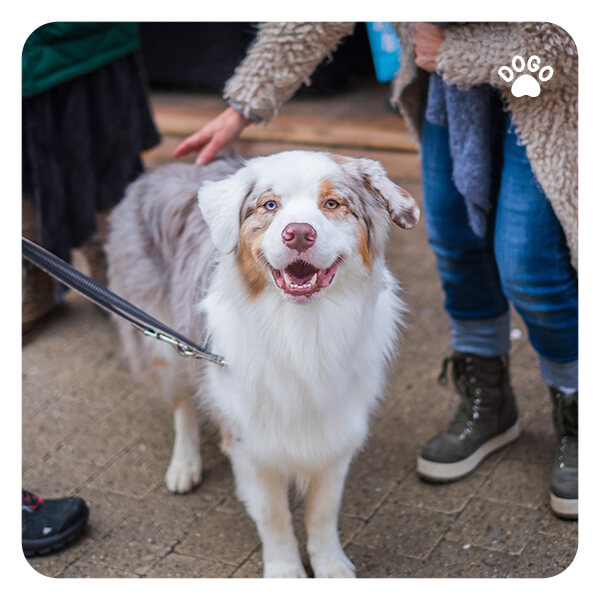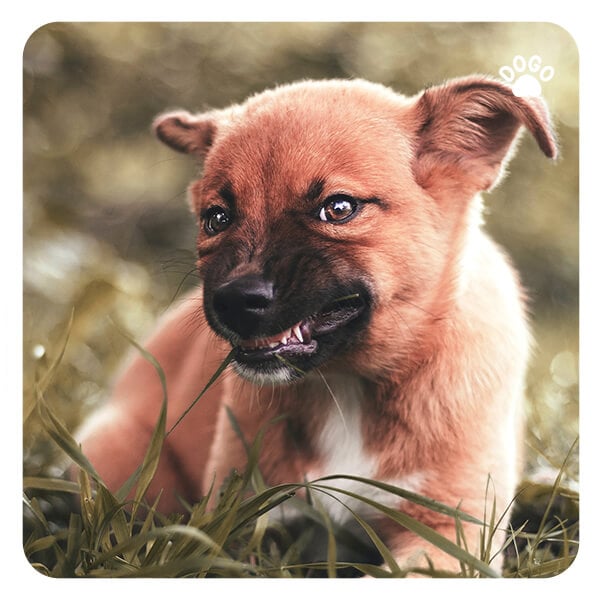Aggression in Dogs – Recognizing the Cause
Post Date:
November 15, 2023
(Date Last Modified: November 13, 2025)
Aggression in dogs can arise from many different triggers and understanding the immediate cause helps keep people and animals safe. Clear recognition of behavioral patterns supports appropriate medical, environmental, and training responses.
Common Types of Aggression
Clinicians typically categorize aggression into 7 main types to help distinguish patterns and guide intervention strategies[1].
- Fear-based: avoidance escalates to growling, snapping, or biting when escape is blocked.
- Territorial/protective: directed at perceived intruders near the dog’s space or household entry points.
- Resource-guarding: defensive behavior around food, toys, resting places, or people.
- Predatory: high-arousal chasing and biting with minimal warning signals; often silent and focused.
- Redirected: aggression aimed at a nearby person or animal when the dog cannot access the original target.
- Maternal: protective aggression around puppies or nesting sites.
- Play-related escalation: rough-mouthed play that crosses into painful or targeted biting.
Each type has characteristic immediate signs: raised hackles, fixed stare, stiff body, lip lift, soft-mouth darting, avoidance, or freeze behaviors. Precise labeling matters because interventions for fear-based aggression differ from measures used for predatory drive, and mismatched treatment can worsen risk.
Medical and Pain-Related Causes
Health problems may produce or amplify aggression through discomfort, altered sensorium, or reduced tolerance for handling.
Pain is identified as an underlying factor in up to 25% of aggressive cases seen in clinical settings, so a veterinary medical workup should be a first-line consideration when aggression is new or changes suddenly[2].
Common medical contributors include musculoskeletal pain (arthritis, injury), neurological disorders (seizures, focal lesions), endocrine imbalances (thyroid disease), and sensory loss (vision or hearing decline) that makes the dog more easily startled or defensive.
When aggression is severe, sudden in onset, or accompanied by other signs such as appetite loss, vomiting, altered gait, or neurologic deficits, prioritize diagnostics including baseline bloodwork, thyroid testing, and targeted imaging or neurologic examination as directed by the veterinarian.
Fluid and medication calculations in acute medical management follow clinical formulas (for example, maintenance fluids often estimated around 50 mL/kg/day), and dose or rate decisions require veterinary supervision and appropriate monitoring[1].
Fear- and Anxiety-Driven Aggression
Fear-driven aggression is defensive: the dog perceives a threat and escalates along a recognizable sequence from avoidance to warning signals and then to contact aggression if the threat continues.
Typical escalation follows measurable stages—freeze or flight, whale-eye and lip lift, growl, snap, and bite—and careful observation of early signals allows safer management and intervention.
Common triggers include strangers, loud noises, confinement, and prior negative experiences that have established conditioned fear responses.
Behavioral interventions focus on desensitization and counterconditioning using short, controlled exposures paired with positive outcomes; desensitization sessions are often brief, 1–5 minutes, repeated multiple times daily to build tolerance without overwhelming the animal[3].
Medication (anxiolytics, SSRIs) may be indicated for moderate to severe cases or when the rate of change required exceeds what behavior modification alone can safely achieve; medication decisions and monitoring require veterinary input.
Resource Guarding and Possessiveness
Resource guarding is a common, specifically patterned form of aggression where a dog acts to retain items or control access to valued resources.
Identifying which items are guarded, the contexts (mealtime, resting place, human approach), and the intensity of the response helps assess risk and prioritize management.
Management strategies include structured “trade” exercises and planned graduated exposure; trade protocols often begin with low-value items and progress across about 3–4 distinct steps so the dog learns that giving up an item reliably yields a better outcome[4].
Safety protocols for owners include avoiding confrontational retrieval attempts, using barriers during feeding, and training supervised access so the dog can predict human approach without fear of loss.
Territorial and Protective Aggression
Territorial aggression is triggered by perceived incursions into a defended area and is often context-specific to home, yard, or vehicle boundaries.
Home territory responses commonly peak when an unfamiliar person or animal approaches the door within the first 5 feet (1.5 m) of the entry point, though thresholds vary by individual dog and environment[5].
Differentiating true protective behavior from fear or social reactivity requires attention to intent and body language: protective postures are typically focused outward toward the intruder, while fear responses may be oriented to escape routes or show avoidance of direct contact.
Environmental modifications (visual barriers, controlled desensitization to knocks or doorbell sounds, management with leashing and crates during expected triggers) reduce incidents and allow supervised training to change the dog’s response pattern.
Social Signals and Misinterpreted Dominance
Dogs communicate with a wide repertoire of signals; accurate reading of submissive, neutral, and aggressive cues prevents mislabeling normal social negotiation as dominance-based pathology.
Submissive signals include lowered body posture, averted gaze, and belly exposing; neutral signals include relaxed body and loose play bows; aggressive signals include stiff stance, direct stare, and raised lips.
The dominance model is an inadequate explanation for most household aggression because it ignores learning history and resource value; modern approaches focus on antecedents, reinforcers, and situational triggers rather than attempting to re-establish a dominance hierarchy.
Training approaches that respect canine communication emphasize positive reinforcement for alternative behaviors, management of triggers, and removal of inadvertent reinforcement for unwanted acts.
Predatory and Play-Related Aggression
Predatory behavior is driven by chase and capture instincts and is physiologically and functionally distinct from defensive aggression; it is often silent, with stalking and rapid chase, and lacks canine appeasement signals.
Play-related escalation shows reciprocal invitations, self-handicapping, and quick recovery between interactions, while true aggression in play is asymmetric and causes avoidance or distress.
Appropriate outlets for high predatory drive include structured chase games with rules, safe fetch or flirt-pole sessions, and impulse-control training to reduce unguided escalation and risk to smaller animals or children.
Developmental, Age-Related, and Hormonal Factors
Behavioral risk changes with life stage, and timing matters for prevention and interpretation.
Puppy socialization windows are generally between 3 and 14 weeks of age, and targeted exposure during this period reduces the later emergence of fear-related aggression when done with appropriate safety and positive associations[5].
Adolescence often brings increased reactivity and testing of boundaries, while geriatric dogs may develop cognitive dysfunction, sensory decline, or chronic pain that increase irritability and decrease tolerance for handling.
Intact hormones can influence territorial and mate-guarding behaviors; neutering or spaying is one consideration among many and its behavioral effects vary by age, sex, and individual history, so surgical decisions should be made with clinical guidance.
Environmental Triggers and Management Practices
Routine, housing conditions, and caregiver interactions strongly shape whether aggressive responses emerge or persist.
Stressors such as long confinement, inconsistent rules, crowded living conditions, or chaotic household routines increase chronic anxiety and the likelihood of reactive aggression.
Preventive measures include regular physical exercise, cognitive enrichment, predictable daily routines, and consistent handling rules; these reduce baseline stress and create learning conditions favorable to behavior change.
Common owner mistakes to avoid are punishment for warning signals, abrupt removal of resources without training, and repeated forced proximity during early warning signs; safer protocols emphasize planned gradual exposure, clearly reinforced alternatives, and environmental management to prevent escalation.
Assessment, Treatment, and Referral
A structured approach begins with a focused history-taking that maps contexts, timelines, and antecedents, followed by risk grading for severity and likelihood of recurrence.
| Type | Common Triggers | Immediate Signs | First-line Management |
|---|---|---|---|
| Fear-based | Strangers, confinement | Avoidance, lip lift, growl | Desensitization, medical check |
| Resource-guarding | Food, toys, resting spots | Stiffness, guarding growl | Trade protocols, management |
| Predatory | Chase opportunity | Silent stalk, focused chase | Controlled outlets, training |
| Territorial | Doorways, yard | Barking, frontal stare | Environmental barriers, desensitization |
Treatment combines behavior modification techniques, environmental management, and, when indicated, pharmacotherapy to reduce anxiety or impulsivity. Medication is considered when behavioral strategies alone are insufficient or when rapid risk reduction is necessary; medication choice, dose, and monitoring must be guided by a veterinarian.
Referral to a veterinary behaviorist or a certified force-free trainer is warranted when risk is moderate to high, when medical causes remain unresolved, or when specialized desensitization protocols and coordinated medication plans are required. Use documented credentialing (veterinary behaviorist diplomas or certified professional trainer credentials) and seek providers who collaborate with a primary care veterinarian.
Sources
- merckvetmanual.com — Merck Veterinary Manual
- avma.org — American Veterinary Medical Association
- aaha.org — American Animal Hospital Association
- wsava.org — World Small Animal Veterinary Association
- vca.com — VCA Animal Hospitals






